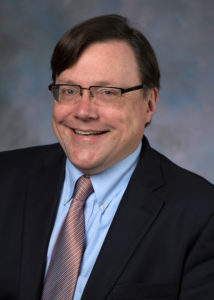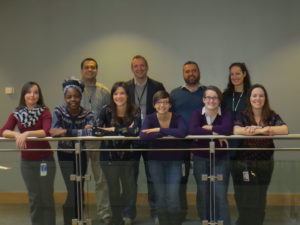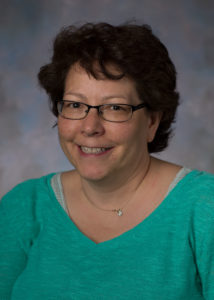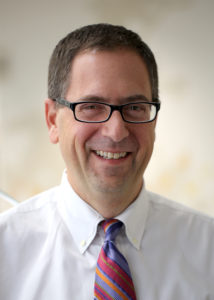Strengthening our network in the Midwest
The FSHD Family Day Conference, hosted by Nationwide Children’s Hospital and the FSH Society on June 11, 2017, drew about 70 patients, families, researchers, and clinicians to Columbus, Ohio. The half-day meeting provided an opportunity for two of the nation’s leading FSHD research centers to share expertise and research advances with patients and families in the region. Patients and caregivers shared their observations and experiences of living with FSHD.

The opening talk by Kevin Flanigan, MD, speaking via Skype, laid out the background of FSH muscular dystrophy, from its earliest description by French physicians Duchenne, Landouzy, and Dejerine, to the pioneering studies by Frank Tyler, who first described a Utah family of 1,249 individuals descended from an individual born in England in 1775, who emigrated to America, converted to Mormonism, had four wives, and produced numerous progeny. Flanigan identified an additional 971 descendants.
Typical symptoms, Flanigan noted, include the curious fact that muscles are affected asymmetrically, and some muscles more than others. A bicep may be quite affected, while the deltoid is fine. He also reviewed the genetic model of FSHD, with the location of the FSHD1 region isolated to the tip of chromosome 4, where a loss of repetitive genetic units called D4Z4 leads to increased expression of the DUX4 gene, which is thought to be toxic to muscle cells.

This introductory talk was followed by Scott Harper, PhD, who provided an excellent primer on the central dogma of molecular biology, explaining how information encoded in DNA is first copied into RNA, which provides instructions to build a protein. He noted that our genome contains the code for approximately 20,000 proteins, but that these proteins are further modified to give rise to 100,000 functionally distinct molecules. A mind-bending fact that Harper shared is that the total DNA in a single human body weighs about 23 pennies. Uncoiled, that DNA would extend 67 billion miles, enough to make 150,000 round trips to the moon.
Harper explained that the central dogma allows us to identify disease genes, clone them, create animal models, and develop gene therapy. With FSHD, he noted that the DUX4 gene is next to a PolyA signal, which is needed to stabilize the gene. He also explained that every gene requires a “promoter” to turn on gene expression. “We don’t understand what turns the DUX4 promoter on and off in FSHD,” Harper said. “What we do know is that the gene is transcribed, undergoes splicing, and is translated. If we disrupt any of these steps, we could interfere with the production of DUX4.”
At the DNA level, DUX4 production can be disrupted by turning off the DUX4 promoter, which has been done in cultured cells, but this is “not viable right now” in humans, Harper said. DUX4 expression could also be blocked by genome editing, for example, by removing the PolyA signal, an approach now being investigated by several labs.
At the RNA level, one can disrupt splicing so that full-length DUX4 mRNA is not made and instead results in a short form of DUX4, which is not toxic. Another tactic is to destroy RNA before it can be translated into protein using a method called RNA interference. Harper’s lab has successfully used RNA interference to knock down DUX4 in human cells and in mice. “It’s our lead strategy now,” Harper said. Lindsay Wallace, PhD, in Harper’s lab is now testing the safety of this strategy.
The Harper lab is also tackling DUX4 at the protein level. Jocelyn Eidahl, PhD, is analyzing the details of how DUX4 protein is modified, to determine which form is responsible for toxicity to muscle cells. Understanding this could point the way to drugs that interfere with the formation of toxic forms of the DUX4 protein.

The next speaker, Miriam Freimer, MD, professor of neurology at Ohio State University (OSU), spoke about two clinical trials for FSHD that have been conducted at OSU. The first trial was for Resolaris, by the biotech aTyr Pharma. “aTyr’s drug is designed to reduce the T cell immune response,” she explained. “Even though FSHD is not considered a disease of immune cells, in the images Dr. Harper showed you, there are immune cells in FSHD muscles.” The Phase 1B/2 trial was able to show that Resolaris is safe and, as dosage was increased, “fairly well tolerated.” The study is “on hold,” but volunteers who want to continue are in long-term extension studies. “We are hoping to get some important data out of that,” Freimer said.
OSU is also involved with the ongoing trial of ACE-083, a drug from Acceleron Pharma. “In healthy volunteers, ACE-083 was associated with a 14.5 percent increase in muscle volume,” Freimer said. “Now, in a two-part Phase 2 trial, we are asking whether ACE-083 increases muscle volume in the tibialis anterior or biceps of FSHD patients.”
There are a few other clinical trials at other research institutes investigating such approaches as electrical stimulation of muscle and testosterone, Freimer noted. “I don’t have more to tell you right now, but in next three to five years,” she said, “I hope there will be an explosion in clinical trials,” thanks to the identification of DUX4 as a therapeutic target.
The next set of talks focused on best practices in managing FSHD. Wendy King, PT, spoke about physical therapy and exercise for FSHD patients and the need for individualized approaches. “Light exercise is helpful, and moderate-intensity exercise is safe and likely to be beneficial,” she said.
An OSU study of ankle-foot orthoses (AFOs) showed that the vast majority of patients were very pleased with carbon fiber-based ones. She also mentioned that Alignmed’s S3 posture brace can be helpful for correcting scapular protraction (“winging” of the shoulder blade).

Richard Shell, MD, spoke on “The Art of Respiratory Care in FSHD.” He noted that abdominal muscles, which play an important role in breathing and coughing, are often weakened in FSHD patients. “You have normal lungs, but the weakened muscles can compromise your breathing,” he explained. He advised FSHD patients to be assessed with spirometry, which measures how much air they can push out of their lungs. Shell also noted that “we use cough assist equipment a lot,” and he recommended pulmonary function testing at least once a year. “If you are experiencing decline, you might want to test more frequently,” he said.
Sleep issues in FSHD patients involve hypoventilation, or shallow breathing, which can cause carbon dioxide to build up in the bloodstream (known as hypercarbia). “You may wake up more tired,” he said. Risk factors for hypercarbia include early age of onset of FSHD symptoms and wheelchair use, but Shell said there is weak evidence of correlation with larger D4Z4 deletion size.
“We should be proactive about screening for any respiratory symptoms,” Shell advised. This includes yearly pulmonary function testing and screening for sleep-disordered breathing.
Genetic testing is one of the more complicated aspects of FSHD, and genetic counselor Jennifer Roggenbuck, MS CGC, masterfully explained the key points. While FSHD Type 1 (FSHD1) is inherited in a classic “autosomal dominant” manner (one copy is sufficient to cause disease, so each child has a 50 percent chance of inheriting FSHD1 from an affected parent), FSHD Type 2 (FSHD2) is passed on with a lower probability because it requires two distinct genetic changes to cause disease symptoms.
With FSHD there is also a phenomenon called germline mosaic, in which the mutation occurs in the egg or sperm of an unaffected parent. In such cases, even if both parents test negative for FSHD genes based on a blood test, each of their children face a risk of inheriting FSHD through the carrier parent’s egg or sperm.
To get a genetic test for FSHD, Roggenbuck advised individuals to begin by asking a neurologist. They may need a referral to a genetic counselor, and should be prepared to provide details of their family history and genetic test results from family members.
One question family members often ask is whether to be tested if you don’t have symptoms but have an affected parent or sibling. Roggenbuck recommended discussing this with a genetic counselor. She noted that a genetic test by itself cannot predict if or when an individual will develop symptoms. Because currently there are no medical interventions to prevent or delay the onset of symptoms, “what you will do with this information is a very individual decision.” She noted that non-symptomatic children are not tested.
The conference concluded with two patients, Maureen Eye and Nicky Dexter, sharing their thoughts about living with FSHD, advocacy, and volunteering for research studies. June Kinoshita, executive director of the FSH Society, reminded patients and families that they are the ultimate experts of FSHD, and by actively engaging in advocacy, making their voices heard, and collaborating with researchers, they will ensure that meaningful, effective treatments will be developed.


Leave a Reply